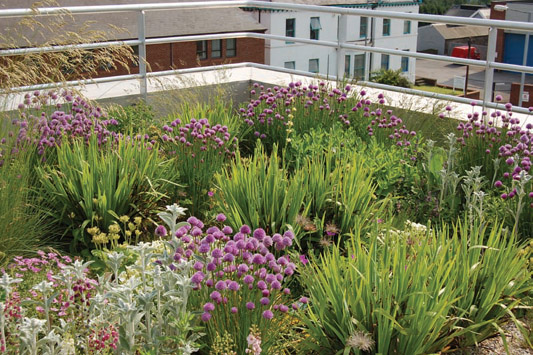

Purple chives (Allium schoenoprasum) in full flower on a green roof. Photo by Nigel Dunnett
AND NOW for the fun part, and in some ways the most important part of a green roof: the plants. The planting on the roof is what, after all, defines a green roof. At the small scale, where roofs are visible and accessible, there is a chance to really experiment with the planting of the roof. In small spaces, a green roof on a garden structure may be the only chance there is for growing plants. A good many reliable tried-and-tested species will put up with the difficult conditions on a green roof. However, for people who have an interest in horticulture, plants, gardens, and ecology, green roofs offer great scope for experimentation. We have still only explored a fraction of the possible plants that could be used on green roofs, and small-scale and garden green roofs offer an excellent opportunity to try out more. Green roofs may also be productive. As more and more people in towns and cities turn to growing their own food, the rooftop offers a chance to grow many of our most familiar herbs and perhaps more substantial crops as well.
Roofs covered purely in substrate or aggregate will still provide some of the benefits that green roofs are known for, but the plant layer will enhance and magnify those benefits. Plants protect the substrate layer from leaching and erosion; they trap, absorb, and evaporate rainwater. they contribute to cooling of the roof surface; they provide food and habitat for invertebrates and birds; and they aid in the capture of air pollutants and provide a sink for atmospheric carbon. At the small scale, where roofs are visible and accessible, plants provide aesthetic appeal. The type and extent of vegetation determines the visual character and quality of the roof. Successful vegetation establishment is therefore central to a successful green roof.
The green roof environment is a particularly harsh one for plant growth, providing very shallow growing medium, limited water and nutrient availability, and increased exposure to wind and intense sunlight. But it is not an impossible environment, and a large number of plants are well adapted to coping with drought stress or very shallow soils, because the places that they grow naturally are very similar: rocky cliffs, sandy or shingly areas, and dry grasslands, for example.
Sedum album growing naturally in stony shingle on Dungeness in Kent, United Kingdom. The area gets very little rainfall, and the plants grow in free-draining stones. The conditions and appearance are much like a green roof, and the vegetation is similar to that commonly used on green roofs. Photo by Nigel Dunnett
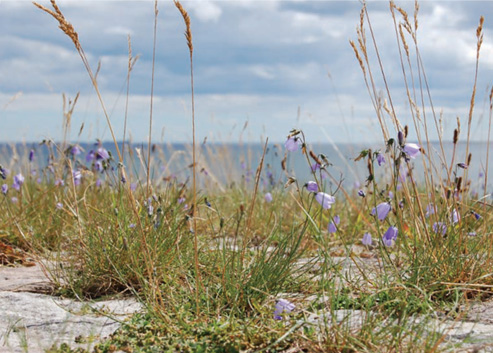
Harebells (Campanula rotundifolia) and fescue grasses growing in thin soil pockets on bare rock on a coastal cliff. Photo by Nigel Dunnett
Plants suitable for green roofs must be easy to establish, stay on the roof over time (either through being tough, hardy, and relatively long-lived or by regenerating easily from seed or vegetatively), and have low maintenance requirements. Many green roof plants have a relatively low and spreading growth form and are therefore effective at covering the surface. Beyond these considerations, more specific plant choices may be related to a particular function or type of roof: the aesthetic qualities of the plant, whether it provides a food source for invertebrates, or whether it is characteristic of a particular habitat or region, for example.
Sedums are, with good reason, the most widely used plants for green roofs. They are supremely drought-resistant and able to grow in shallow, free-draining substrates. Indeed, many sedums grow naturally on bare rock surfaces and on sands and gravels. Sedums were widely used in the early days of the development of extensive green roofs precisely because they naturally colonized aggregate-covered flat roofs. However, the range of potential plants goes far beyond sedums.
For much more detailed discussions of plants for green roofs, we recommend Green Roof Plants by Ed and Lucie Snodgrass (Timber Press, 2006) and Planting Green Roofs and Living Walls by Nigel Dunnett and Noël Kingsbury (Timber Press, 2008).
The depth of the growing medium is the single greatest deciding factor on what can be grown on a green roof. On very shallow depths of substrate (less than 50 mm, 2 in), only the toughest and most specialized species will survive, and the growth of those will be sparse and stressed where growing medium is especially thin. We always aim to achieve a minimum growing medium depth of at least 100 mm (4 in) where this is possible. If substrate depth can be increased, then the range of potential plants also increases. But greater substrate depth brings with it two problems: the loading on the roof increases, and conditions start to become very favourable for a wide range of plants, including weeds, and you have a greater need for maintenance to keep your desired plantings in place. For this reason, we recommend using a substrate that is not high in nutrients even at the greater depths, unless required for a specific purpose, such as growing vegetables. Once substrate depths increase beyond 250 mm (10 in), we are moving into the territory of the conventional roof garden, involving trees, shrubs, bushes, lush lawns, and so on, and this is really outside the scope of this book.
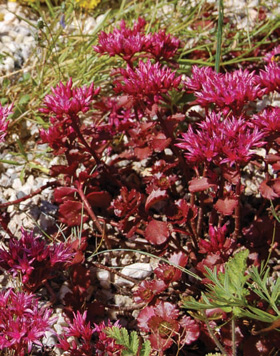
Sedum spurium in flower. Photo by Nigel Dunnett
Succulent species store water in their leaves and have considerable moisture-conserving abilities. The succulents most commonly used on green roofs are sedums: mostly evergreens, with year-round plant cover and a wide variety of leaf shapes and colours. Most Sedum species flower in May and June, and the common flower colours are yellow or pale pink. Reliable and widely used species include Sedum album, Sedum acre, and Sedum rupestre. These species all have relatively small leaves, as does Sedum hispanicum. Sedum spurium has larger, flatter leaves and provides a visual contrast to the other types in a mixture. Other commonly used succulents include Delosperma, with bright colourful flowers, although many are not frost tolerant, and low-growing cacti such as Opuntia.
Sedums planted in wide bands in summer at Emory Knoll Farms. Photo by Ed Snodgrass
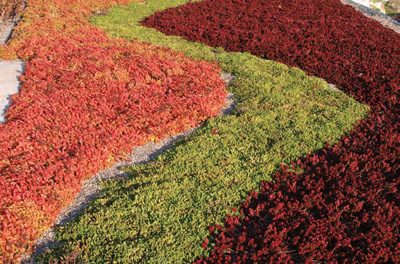
The same sedums in autumn. Photo by Ed Snodgrass
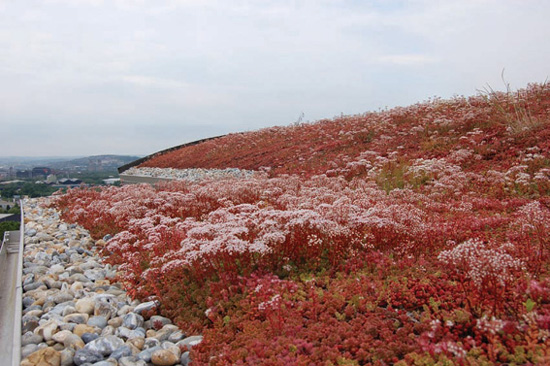
Mixed sedums, with Sedum album in flower. Photo by Nigel Dunnett
Prickly pear cactus (Opuntia), here growing on a green roof in Italy, is a good green roof plant for arid climates. Photo by Emilio Ancaya, Living Roofs, Inc.
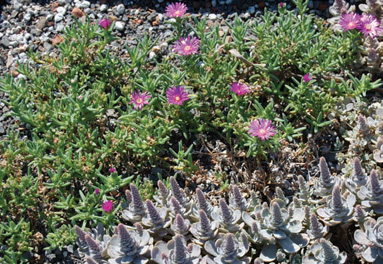
Delosperma cooperi, with beautiful daisy flowers, with another succulent, Orostachys boehmeri. Photo by Nigel Dunnett
Sedums have come to have a rather negative association on ecological and biodiversity grounds. This is to some extent unfounded and has more to do with the way they are used, rather than with the plants themselves. Sedum-only mats used in super-lightweight green roofs with little or no substrate will result in low-diversity roofs, sometimes with sparse or poor plant growth. However, when used in substrate-based systems and mixed with a wider diversity of plants, sedums can serve as an essential fail-safe component against summer drought and provide an excellent nectar source during the summer flowering period.
Herbaceous and alpine plants give visual, structural, and ecological diversity to a green roof. Widely used and reliable species include tunic plant (Petrorhagia saxifraga), with pink flowers on dense, finely leaved plants, and chives (Allium schoenoprasum). Dianthus species such as Dianthus deltoides and Dianthus carthusianorum are effective, the latter seeding freely around a roof from year to year.
Petrorhagia saxifraga growing en masse from seed on a green roof, with Dianthus carthusianorum emerging. Photo by Green Estate Ltd.
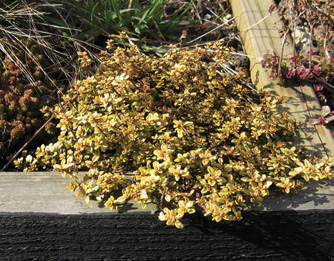
Golden thymes keep their bright appearance right through the winter. Photo by Nigel Dunnett
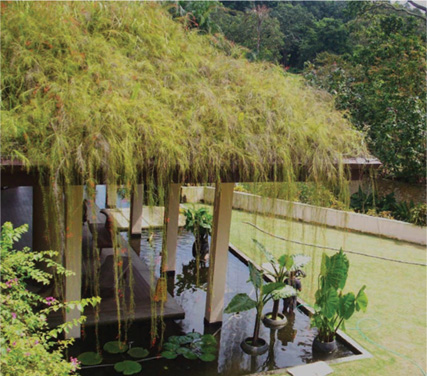
In humid tropical climates, a very different range of green roof plants can be used. This pavilion at the Singapore Botanical Gardens is covered in ferns. Photo by Ben Nicholson
Grasses can form the sole component of green roof vegetation, but on their own grasses can be prone to drought damage and die-back on unirrigated green roofs. As part of mixed vegetation, grasses provide visual contrast and additional structural diversity. Freely seeding grasses can dominate a roof and thus lower vegetation diversity. Koeleria glauca and Koeleria macrantha are suitable, as are many Festuca species.
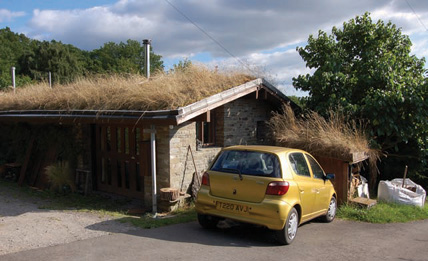
Unirrigated grass roofs dry out and ripen in the summer. Photo by Nigel Dunnett
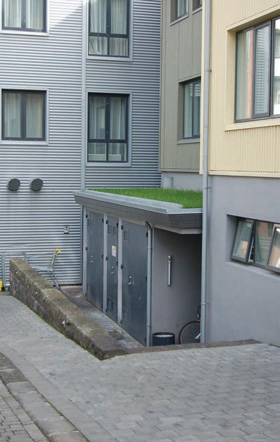
A grass roof in a small space. Photo by Nigel Dunnett
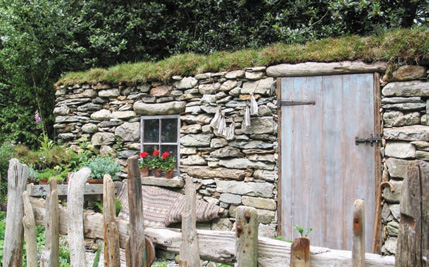
A simple turf roof. Photo by Wendy Allen
Limestone grasslands grow in very thin, poor, dry soils over pure rock. These conditions can be mimicked on a green roof. Photo by Nigel Dunnett
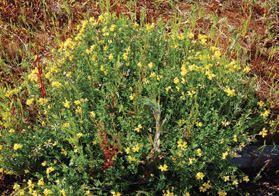
Bird’s foot trefoil (Lotus corniculatus). Photo by Nigel Dunnett
The increasing focus on green roofs for biodiversity has led to great interest in the use of native plant species. Every region in the world will have natural habitats containing species suitable for green roofs. In temperate climates, dry grassland plant communities are a good source of possible plants, with calcareous grasslands (chalk and limestone) being particularly suitable. Native species might be used on green roofs in two ways. Some natives may be substituted for non-natives, as part of a conventional planting mix, or more of a habitat creation or restoration ecology approach may be used, whereby an attempt is made to recreate a particular plant community. For example, reliable northern European species include cowslip (Primula veris), yarrow (Achillea millefolium), wild thyme (Thymus drucei), bird’s foot trefoil (Lotus corniculatus), rough hawkbit (Leontodon hispidus), wall germander (Teuchrium chamaedrys), and sea campion (Silene uniflora).
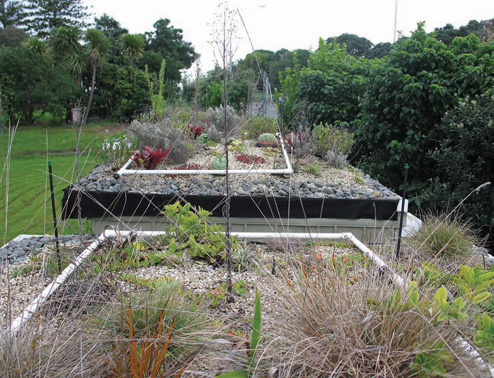
Trials of native New Zealand plants for green roofs on small sheds. The species have a very exotic appearance compared with northern and western European green roof plants. Photo by Robyn Simcock
Smaller bulbs are invaluable in providing bright colourful highlights on a green roof. Bulbs which come from rocky desert environments, such as Tulipa species, are pre-adapted to withstanding summer heat and drought in very stony soils. Grape hyacinths (Muscari) are very reliable, as are dwarf Narcissus. In this area, there is still much research to be done on what will and won’t work.
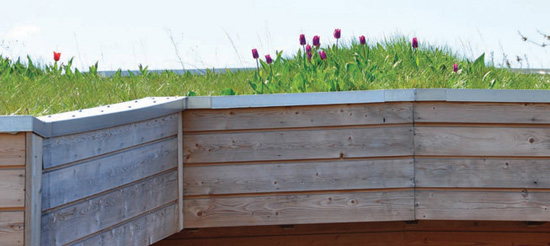
Purple tulips on mounded substrate in a grassy green roof in Sheffield, United Kingdom. Photo by Nigel Dunnett
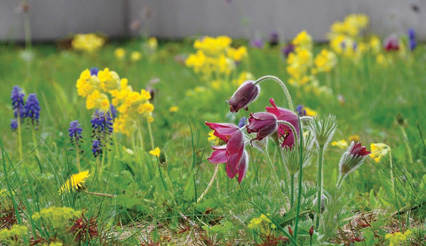
Blue grape hyacinths (Muscari. with a red form of pasque flower (Pulsatilla vulgaris) and yellow cowslip (Primula veris). Photo by Nigel Dunnett
Annual plants grow, flower, and set seed within a single growing season. They provide a burst of spring and summer colour, and many will seed themselves from year to year, filling gaps and popping up unexpectedly. Desert annuals and those from Mediterranean climates are particularly successful on green roofs. Species which prove reliable include sweet alyssum (Alyssum maritimum), which has strongly honey-scented white flowers and will carpet the ground. Tickseed (Coreopsis tinctoria) will thrive on a green roof, provided the soil is not too shallow. Fairy toadflax (Linaria maroccana) flowers very quickly and is good for providing quick colour while more slowly growing species or perennials become established. At a small scale, there is nothing to lose by scattering a few seeds of whatever comes to hand—some will work and some will not.
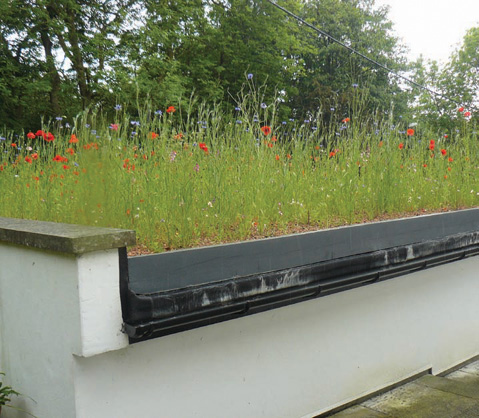
A colourful mix of native cornfield annuals on a garage roof. Photo by Green Estate Ltd.
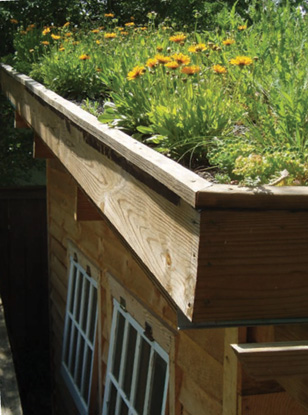
Pot marigolds (Calendula) among other annuals on a shed green roof. Photo by Emilio Ancaya, Living Roofs, Inc.
Moss comes naturally onto most roofs in most regions that are not arid, and it will commonly colonize very thin or poorly draining green roofs, where it can be seen as a sign of a very stressed or unhealthy roof. However, moss is extremely lightweight and will also absorb copious amounts of water. There have been proposals to exploit the value of moss in situations where anything else would create too much weight, using the old technique that gardeners employ to make new stone appear very old—painting a slurry containing milk or yoghurt onto the surface to encourage moss colonization.
In crowded, high-density urban environments, interest is turning to using rooftops to grow food. Many typical aromatic culinary herbs come from Mediterranean climates and are very suitable for green roofs, provided the substrate is free-draining. Thymes, chives, oregano, rosemary, and lavender, for example, are frequently grown in green roofs.
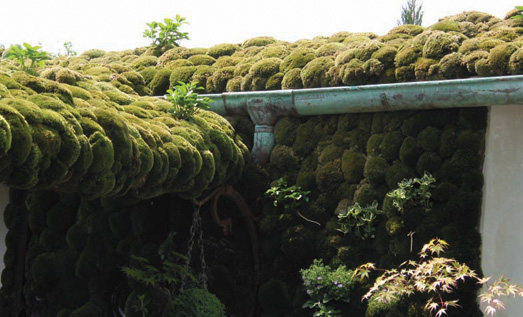
This Japanese-style moss roof will only succeed in wetter climates or in shade. Photo by Wendy Allen
Growing more conventional crops requires more manipulation of the environment. Irrigation is certainly a requirement, substrate depth needs to be sufficient, and maintenance will certainly be great. The Eagle Street Rooftop Farms is an inspiring example of how a Diy mentality and active community and volunteer input can make this happen in an inner-city environment, even though the project is large in scale and a commercial build-up had to be used. At the opposite end of the scale, the Wheeler Street Leangreen House illustrates how food can be grown in a very small domestic space. The roof both provides a space for growing vegetables and fruits, and, as a cat- and slug-free space, is an ideal starting point for vegetable seedlings to be planted in the garden below. The Greensgrow Farms project illustrates hydroponics as a growing technique where there is no cultivatable soil. The topic of growing food at rooftop level is still very experimental, and the people doing it are pioneers. There is much still to be learned.
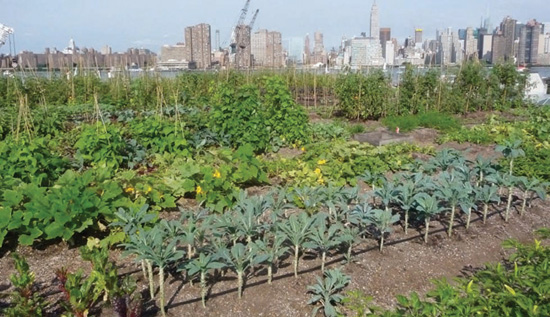
Vegetables growing on the rooftop farm at Eagle Street, Brooklyn. Photo by Annie Novak
The way that plants are arranged and used on a roof is a matter of personal choice, and the design possibilities are wide. Opportunities range from the use of simple monocultures through to complex naturalistic mixtures. Green roofs don’t have to be naturalistic: plants can be used in bold blocks and patterns.
Extensive green roof planting is commonly done in simple mixtures and monocultures. The sedum roof is the most familiar example. Although often described as a monoculture, this is not technically correct because such roofs often contain several Sedum species giving rise to a range of textures and leaf and flower colours. The other familiar example is the grass, sod, or turf roof, although over time grass-only roofs can evolve into more species-rich communities.
These seemingly simple roofs can involve relatively high maintenance if the original vegetation is desired to be retained indefinitely. Almost inevitably, sedum-only roofs will be invaded by other types of plants. Should these be removed, or should we let nature take its course? Grassy monocultures usually require irrigation to stay green, or they brown off in summer or winter depending on your region.
Visually, simple low-diversity roofs tend to be rather monotonous or two dimensional. At the small scale, or where roofs are very visible or accessible, people tend to want a bit more aesthetic variety, textural contrast, and seasonal highlights, as well as a wider range of feeding opportunities for wildlife.
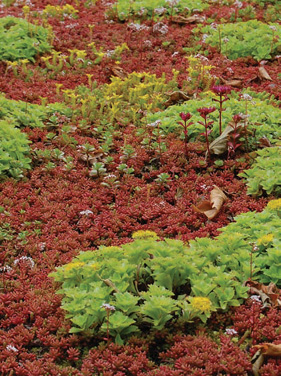
Mixed sedums. Photo by Nigel Dunnett
Planting in patterns is another design alternative. Groups, drifts, or sweeps of plants can create a visually exciting roof. Each group may be of a single species, or the drifts and masses can be of different vegetation types or mixtures, perhaps related to drifts and masses of varying substrate types on the roof.
Again, this is not a maintenance-free approach. Maintaining the desired patterns may require a lot of intervention to stop one group mingling with another or to remove invading species. On the other hand, for many people, the development of a roof over time is one of the pleasures of having a green roof, and the breaking down and disintegration of patterns is a fascinating process.
Grouping plants in more complex mixtures is a good means of achieving a visually satisfying end point with relatively low maintenance requirements. Plants can be distributed singly or in small groups of the same species relatively randomly across the roof surface. Of course, this is what happens anyway if a roof is seeded, but the same naturalistic and spontaneous effect can be obtained through planting. At the simplest level, this may involve mixing plants with contrasting foliage or form among low-growing sedums, using chives, grasses, or drought-tolerant wild-flower species, for example. It may involve more studied combination of plant forms, colours, and textures. Or it may be a random mix of species chosen for their wildlife value or because they are members of a particular native plant community. Maintenance of mixtures can be a relatively simple affair, tweaking here and there to prevent the dominance of any one species.
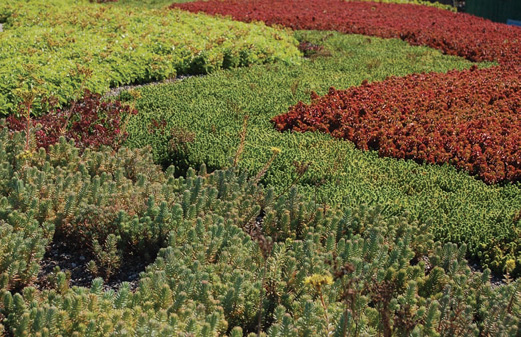
Three different Sedum species growing in separate drifts provide fantastic contrasts in colour and texture. Photo by Nigel Dunnett
This roof was planted by randomly distributing small groups of different species across the roof. Maintenance is much easier than if each species had to be kept distinct in separate larger drifts or clumps. Photo by Nigel Dunnett
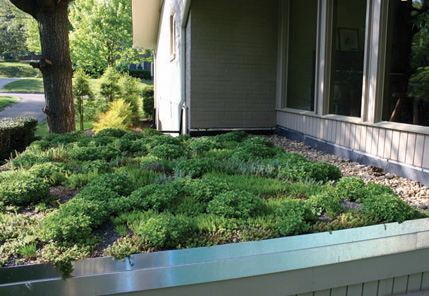
This random mix of sedums and perennials has pleasing contrasts in texture. Photo by Emilio Ancaya, Living Roofs, Inc.
Meadows are a particular type of complex mixture. Green roofs are well suited to making wildflower meadows, because the difficult growing conditions tend to keep out the very vigorous grasses that outcompete the desirable wildflowers. Meadows can be created easily from seed. For a flower-rich effect, it is best not to include grasses at the outset or to include them only in small amounts. Grasses will come in anyway. By not using grasses initially in high density, the flowering plants have a greater chance to establish.
Several options are available for vegetating a green roof, including pre-grown vegetation mats, plug planting, cuttings, seeding, and natural colonization. There is no need to be restricted to using one method only. For example, plug plants can be used to create reliable and known vegetation at low density, with a seed mix sown between to create a greater vegetation cover at lower cost. Natural colonization can be enhanced by sowing and planting of desired species onto biodiverse roofs. Pregrown vegetated mats can also be oversown.
Vegetation mats offer instant greening to a known specification, and in some instances this may be the only option available. In these systems, a geotextile mat supports a thin layer of growing medium, into which the plants are established at the plant nursery. The mats are transported, either flat or rolled up, to the green roof site. By far the most common type is sedum mats, composed of a mix of different Sedum species. Very often such mats are laid over minimal depths of substrate or directly onto a moisture retention mat, thereby creating a very lightweight system. Good contact between the vegetation mat and whatever is underneath is essential during the establish phase, and irrigation may be necessary.
A green roof meadow in Sheffield, with yellow Anthemis tinctoria. Photo by Nigel Dunnett
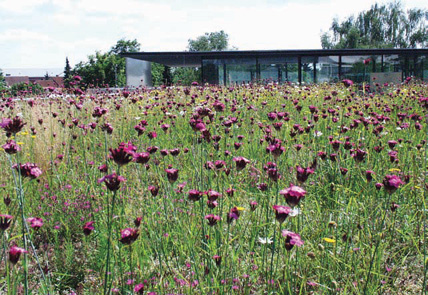
A beautiful green roof meadow with Dianthus carthusianorum. Wildflower meadows on green roofs can be very successful because the stressful conditions keep out dominant and vigorous grasses. Photo by APP Dachgarten GmbH
Species-diverse vegetation mats are also available for green roofs. These include a range of flowering plants and may or may not contain sedums. Such mats have greater aesthetic appeal and biodiversity value, but must be used with a substrate layer.
Traditional turf may also be used to create instant vegetation cover. Wildflower turf can contain a good range of appropriate native species. However, the use of turf on a green roof should only be considered where irrigation is available for establishment and a reasonable depth of growing medium is being used.
Given the long-term nature of green roofs, instant complete vegetation cover is not necessary for effective functioning, unless it is essential for aesthetic or practical purposes, such as when a limited time is available for vegetation establishment. The following methods require a longer establishment time, but they are generally less expensive options than pregrown mats.
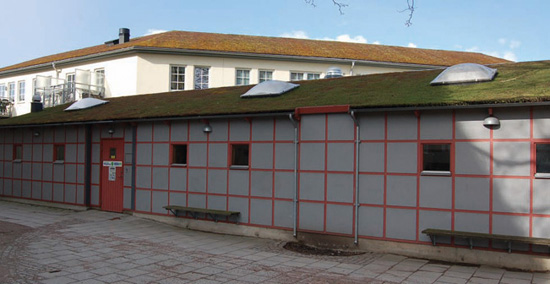
Green roofs on houses and storage sheds created with a pregrown sedum mat. Photo by Nigel Dunnett
Plugs are small rooted cuttings or seedlings grown in cell trays containing compost. They are relatively inexpensive and allow a roof to be vegetated with a known mix of plants in the desired densities and arrangements. The plugs are planted directly into the substrate spread on the roof. The typical density of planting is ten to fifteen plants per square metre. Planting in staggered rows ensures a more even coverage. The plugs should not be allowed to dry out in the trays and should be thoroughly moistened before planting—dry plugs will hinder or prevent root outgrowth into the surrounding green roof medium—and the roof kept moist until the plug plants begin to root out into the growing medium. Sedum species are also available in larger plugs or discs which are established in exactly the same manner.
In some instances, desired plants may not be available as plug plants, and container-grown plants may have to be used. The smallest container size possible should be used, because the mass of highly organic compost in most nursery container plants can hinder new root growth out into the harsher green roof growing medium. If container plants are to be used, the roots should be loosened prior to planting to enable the greatest contact of roots with the green roof medium.
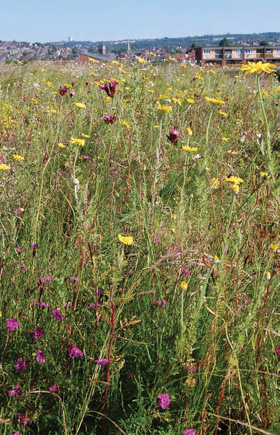
Green roof vegetation created using a species-rich pregrown mat by Lindum Turf of North Yorkshire. Photo by Nigel Dunnett
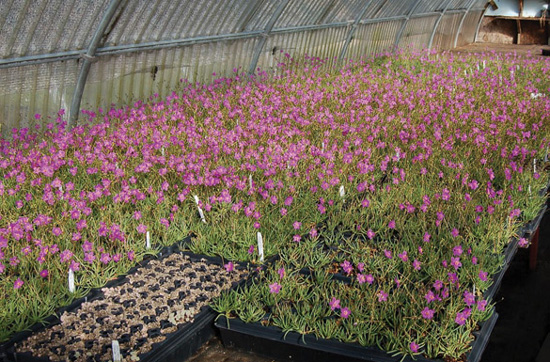
Trays of green roof plug plants in production. Purple-flowered Talinum calycinum is a beautiful annual or short-lived perennial. Photo by Nigel Dunnett
Sedum species root readily from fragments of leaves and stems. Bags of sedum cuttings are readily available, and these are strewn across the surface of the levelled growing medium on the roof. It is essential that the cuttings remain moist until rooting has occurred. On a large scale, hydro-seeding techniques are used, whereby the cuttings are pumped out onto the roof in a slurry of water-retentive gel and nutrients. The additional moisture-holding capacity of the gel aids establishment.
Seeding as an establishment technique on green roofs has been underused to date, but it is likely to feature more prominently in the future. It is a relatively inexpensive method, and the use of a seed mix across an entire roof surface enables different component species to find the conditions that suit them best. However, the precise composition of the vegetation cannot be guaranteed because of the variability of germination of species from year to year and site to site.
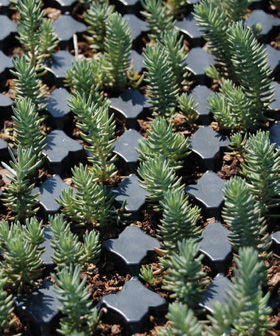
A tray of Sedum reflexum plugs. Photo by Nigel Dunnett
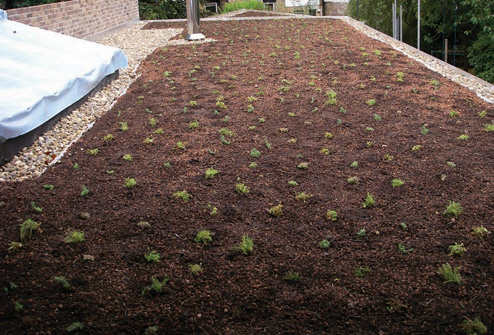
A green roof newly planted with plug plants. Photo by Green Estate Ltd.
Seeding is undertaken on to the bare growing medium surface. If the roof has been standing unvegetated for some time, it will be necessary to loosen or lightly cultivate the surface and remove any unwanted seedlings. Because quantities of seed are small (for example, 3−4 g/m2 [0.1 oz/sq yd] for grass seed, 5−8 g/m2 [0.2 oz/sq yd] for wildflowers only), the seed is often mixed with a bulking agent, such as sand or sawdust, to enable even spreading. The growing medium should be moist prior to sowing. After sowing, the seed should be lightly raked and firmed into the surface. The roof should be kept moist during dry periods, and ideally, the area covered with netting to keep birds off the surface.
An alternative approach that is particularly useful if the growing medium is very coarse and seeds are likely to fall or be washed deep into the substrate is to spread a thin layer of sand or fine growing medium containing the required seed mix over the surface. The seed will already be incorporated well into the growing medium, and therefore the surface will only require a light firming.
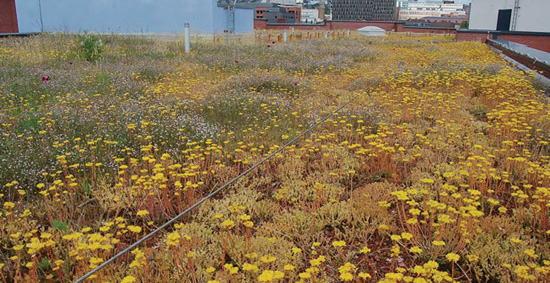
This green roof in Sheffield, United Kingdom, was created by sowing the same seed mix over the entire roof. Slight differences in substrate depth across the roof have resulted in differences in the vegetation. Photo by Nigel Dunnett
Seeding is best undertaken in the autumn or in late winter and spring. The dry hot summer months should be avoided. Some species require winter chilling, and therefore spring sowing of the plants would not be effective.
The most cost-effective and ecological approach to vegetating green roofs is to allow natural colonization, enabling plants which blow on to the roof surface naturally or are brought there by birds to establish unaided. This is a good technique for vegetating biodiverse roofs. Those plants which establish, survive, and persist will be, by definition, well-adapted to the green roof conditions and will also be reflective of the typical vegetation of disturbed sites in the immediate area. This approach is best used with infertile or free-draining substrate, because rich and productive substrates can encourage a rank, low-diversity outcome. However, natural colonization leaves very little control over the composition of the vegetation, and only certain types of plants are able to get to the roof (for example, those which are dispersed easily by wind). Many of the really tough and reliable green roof plants are not so mobile and would never get to the roof by these means. Because of the lack of control over the vegetation and the type of plants that arrive easily, the aesthetic appearance can be very wild. Conversely, some very interesting and unexpected species can arrive, creating a unique and distinctive roof.
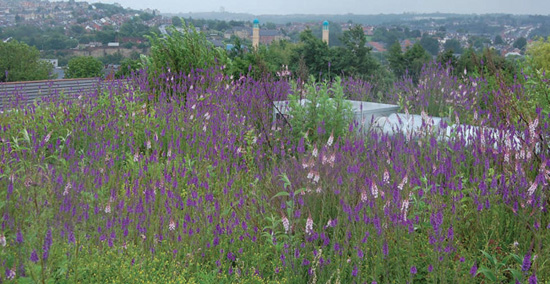
The purple toadflax (Linaria purpurea. on this green roof in Sheffield, United Kingdom, colonized the roof naturally. Photo by Nigel Dunnett
The prospect of having to commit to ongoing maintenance of a green roof in what might be a difficult and inaccessible situation can be one of the things that puts people off having a green roof. But in reality, the amount of maintenance required can be relatively slight or almost nonexistent. One of the key factors in minimizing maintenance is to get the substrate right. A low-nutrient, free-draining substrate is going to cause much less of a weed problem compared to a highly organic and nutrient-rich material.
There is a common fallacy that green or grassy roofs need to be mown or grazed. In reality, roofs probably do not need any cutting back—the dried-out flower heads and stalks make a good silhouette against the sky in the winter and may be good sources of seed and shelter for birds and invertebrates.
Vigorous woody plants, such as tree and shrub seedlings, should be removed from a green roof. Not only may the roots present a problem to the underlying layers of the roof, but, if they reach any size, they are liable to be blown over, thereby pulling up the surrounding substrate and vegetation.
With time, a green roof may become very low in nutrients, and there may be a need for the more horticulturally inclined roofs to be given a top-up—either with an organic slow-release fertilizer or by top-dressing with compost or additional substrate.
Of course, we assume that maintenance is always something to be avoided, but for many people who have their own small-scale green roof, tinkering around with it and keeping it looking good is part of the pleasure. Green roofs can be gardened to whatever level of intensity you are prepared to put in.